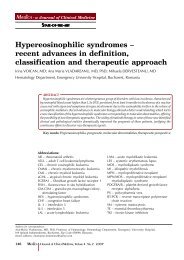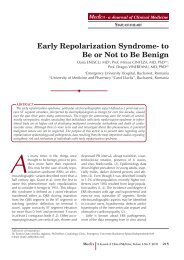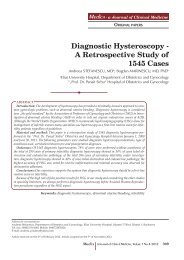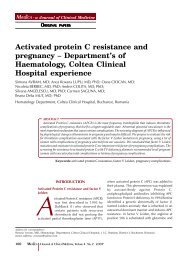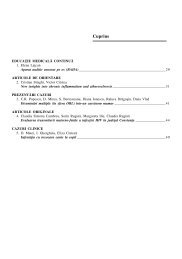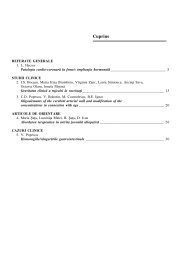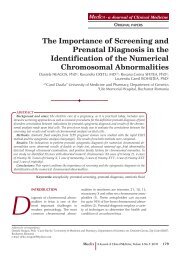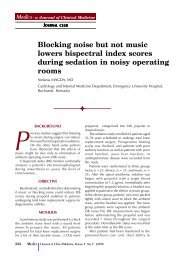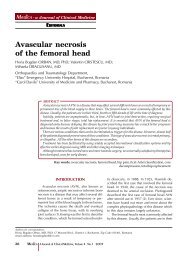Treatment with Cyclophosphamide for steroid-resistant nephrotic ...
Treatment with Cyclophosphamide for steroid-resistant nephrotic ...
Treatment with Cyclophosphamide for steroid-resistant nephrotic ...
Create successful ePaper yourself
Turn your PDF publications into a flip-book with our unique Google optimized e-Paper software.
MK pg 168<br />
TREATMENT WITH CYCLOPHOSPHAMIDE FOR STEROID-RESISTANT NEPHROTIC SYNDROME IN CHILDREN<br />
due to a poor remission rate after 5 years and<br />
to well known adverse effects, including the<br />
oncological risk (2).<br />
We report our experience on the effectiveness<br />
of CP in children <strong>with</strong> SRNS. <br />
METHODS<br />
We per<strong>for</strong>med a retrospective study in 51<br />
children <strong>with</strong> idiopathic SRNS who have<br />
been treated <strong>with</strong> CP in the IVth Clinic of Pediatrics<br />
from Iasi, beginning from 1994 to the<br />
end of 2009. We included 45 patients <strong>with</strong> primary<br />
<strong>steroid</strong>-resistance and 6 patients <strong>with</strong> secondary<br />
<strong>steroid</strong>-resistance. Only patients who<br />
received at least 2 months of oral CP or 3 pulses<br />
of i.v. CP and those followed <strong>for</strong> at least 1<br />
year were included.<br />
The treatment <strong>with</strong> CP was introduced after<br />
4 weeks of Prednisone course 2 mg/kg/day and<br />
3 alternative boluses of Methilprednisolone 30<br />
mg/kg/day.<br />
1.<br />
2.<br />
3.<br />
4.<br />
We considered the next parameters:<br />
age at onset of <strong>nephrotic</strong> syndrome<br />
the hystopathological spectrum of renal biopsies<br />
the treatment duration and the cumulative<br />
dose per kilogram of body weight, in case of<br />
oral and intravenous treatment<br />
the evolution after therapy <strong>for</strong> those patients<br />
followed <strong>for</strong> at least one year.<br />
We used CP in a dose of 2 mg/kg/day, daily,<br />
<strong>for</strong> oral treatment (protocol I), 400 mg/m2/<br />
dose, i.v. in monthly boluses, 6 months (protocol<br />
II), and 400 mg/m2/dose, i.v. in monthly<br />
boluses, 6 months, followed by 3 boluses at 3<br />
months interval (protocol III).<br />
Associated medication during CP consisted of<br />
alternate-day Prednisone, in a tapered dosage.<br />
We considered as a good response – remission<br />
– the absence of proteinuria <strong>for</strong> 3 consecutive<br />
days and, as persistent remission, at least<br />
6 months of survey <strong>with</strong> absent proteinuria<br />
from the end of therapy <strong>with</strong> CP.<br />
Statistical analysis was per<strong>for</strong>med using the<br />
SPSS 16.0 <strong>for</strong> Windows. A p value of less then<br />
0.05 was defined to indicate a significant difference.<br />
<br />
RESULTS<br />
The age at the onset of <strong>nephrotic</strong> syndrome<br />
varied between 13 and 192 months, <strong>with</strong> a<br />
mean of 99.14 months, and 2 frequency picks<br />
at 84 and 168 months.<br />
Renal biopsies were per<strong>for</strong>med only in 47<br />
cases be<strong>for</strong>e initiation of oral or i.v. treatment<br />
<strong>with</strong> CP. The hystological findings included:<br />
• mesangioproliferative glomerulonephritis<br />
(MesPGN) – 22 patients (43,1%),<br />
• minimal change <strong>nephrotic</strong> syndrome<br />
(MCNS) – 9 patients (17.6%),<br />
• membranous nephropathy (MN) – 8 patients<br />
(15.7%),<br />
• focal segmental glomerulosclerosis<br />
(FSGS) – 4 patients (7.8%),<br />
• membranoproliferative glomerulonephritis<br />
(MPGN) – 4 patients (7.8%).<br />
Patients and treatment characteristics, according<br />
to the hystopathological spectrum and<br />
response to the therapy <strong>with</strong> CP, are shown in<br />
Table I.<br />
The cumulative dose of CP varied between<br />
26.6 and 490.9 mg/kg, <strong>with</strong> a mean of 104.59<br />
mg/kg. The duration of treatment <strong>with</strong> CP varied<br />
according to the protocol type. We treated<br />
9 children <strong>with</strong> protocol I (17.6%), 24 children<br />
<strong>with</strong> protocol II (47.1%), and 18 children <strong>with</strong><br />
protocol III (35.3%).<br />
There is significant correlation between the<br />
age of children at the onset of <strong>nephrotic</strong> syndrome<br />
and the protocol we used (p=0.027).<br />
Also, there is a strong correlation between the<br />
protocol type and the cumulative dose of CP<br />
(p=0.001), the cumulative dose being higher<br />
<strong>for</strong> the patients treated <strong>with</strong> protocol I. Twentytwo<br />
patients (43.1%) experienced a sustained<br />
remission while on CP therapy and one year<br />
after the onset of treatment, whereas 29 children<br />
(56.9%) had only clinical or no remission.<br />
There is no correlation between the histological<br />
type and remission of the SRNS (p=0.258).<br />
Complete remission was noted in 11.8% of<br />
patients under protocol I, in 17.6% of patients<br />
under protocol II, and in 13.7% of patients under<br />
protocol III.<br />
The adverse effects noted in our cases were:<br />
leukopenia (1 patient), acute chemical cystitis<br />
(1 patient), allopecia (1 patient) and two cases<br />
<strong>with</strong> severe infections (tuberculous serositis – 1<br />
patient, primary peritonitis – 1 patient). <br />
DISCUSSION<br />
Only a small percentage of the children<br />
<strong>with</strong> <strong>nephrotic</strong> syndrome fail to enter in<br />
remission <strong>with</strong> Prednisone, the question being<br />
about what is the treatment of choice <strong>for</strong> that<br />
specific cases.<br />
168 Maedica A Journal of Clinical Medicine, Volume 5 No.3 2010




